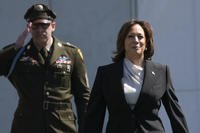Yoga pants are OK, but not crop tops that don't cover the stomach. Hats are now allowed indoors, but the brim can't cover a student's face. That T-shirt advertising Grizzly tobacco or embossed with a cheeky finger to the Establishment? Still not allowed inside a Department of Defense Education Activity school.
The military school system, known as DoDEA, has announced a new "gender-neutral" student dress code that officials say standardizes the rules across the system and doesn't prohibit students from "self-expression in their style of dress or grooming, or discriminate against" them if they comply.
The dress code will go into effect at all 160 DoDEA schools in the system, including the U.S., Puerto Rico, Cuba, the Pacific and Europe, as of July 1.
Read Next: Air Force Superiors Warned Alleged Pentagon Leaker Multiple Times Before Arrest
The new rules, first reported by Stars and Stripes, require students to essentially be clothed from their shoulders to mid-thigh. They must wear tops with sleeves -- no tanks or spaghetti straps unless they are attending a school-sponsored formal event; solid clothing that is not transparent that "fully covers the top and bottom from armpit to mid-thigh;" and safe shoes, including open-toed shoes with a strap across the heel.
No longer will they need to measure the distance between their hemline or shorts and their knees. But miniskirts and short shorts still won't be allowed, given that most don't come remotely close to mid-thigh.
The new rules were designed to provide a "safe and orderly environment that promotes respect for learning and a common identity," according to the DoDEA announcement on its website.
Will Griffin, DoDEA's public affairs officer, said they provide a consistent dress code across the schools that are easily understood by students, parents, teachers and administrators.
"We have a highly mobile student population that moves from public school districts to our districts, from out of our districts to public schools, and from one DoDEA school to another, so having a dress code that is equitable for all students and consistent across our system, and is also in line with kind of what we see across the nation, just makes life easier for our students and for our parents," Griffin said.
Before the uniform dress code was published, many schools had their own versions based on a disparate set of rules. For example, at some facilities, tank tops or halters were barred while they were permissible elsewhere. Some specifically addressed what boys or girls could wear or not wear and were tailored to articles of clothing.
Now, both boys and girls can sport ripped denim and wear hats on days when their hair is "meh."
The new set of rules will accommodate style changes and personal taste while ensuring that clothing isn't a distraction, Griffin said.
"The point of a student dress code, really, is to support an educational environment that's conducive to learning," he said.
There are a few things that remain barred, according to the DoDEA. These include clothing that contains language or images that promote violence, drugs, alcohol or tobacco; curse words; illegal items or activities; or any picture, language or logo that could be construed as pornographic, obscene or derogatory to any group based on race, ethnicity, gender, sexual orientation, disability or religion.
And bedroom slippers aren't allowed, unless authorized by school administrators for a reason or fun day.
The dress code was developed by the DoDEA's Education Policy Division, working with its Civil Rights Steering Committee, as well as diversity, equity and inclusion specialists. The group solicited input from students, parents, school leadership and teachers, drawing 467 comments that were used to revise the dress code.
The process took about a year, according to Griffin.
"There was an overwhelmingly positive response to the opportunity to provide feedback, particularly from our students," Griffin said.
Schools still may apply for exceptions by submitting a form to their district superintendents explaining the need for an exemption in their environments.
Students who violate the dress code may be subject to corrective actions, such as being removed from class and counseled, made to cover up the offending article of clothing, asked to change or subject to further disciplinary action if warranted, according to the DoDEA.
-- Patricia Kime can be reached at Patricia.Kime@Military.com. Follow her on Twitter @patriciakime.












